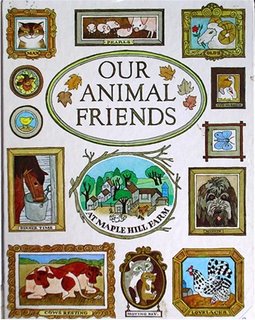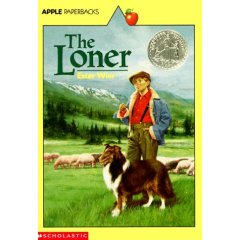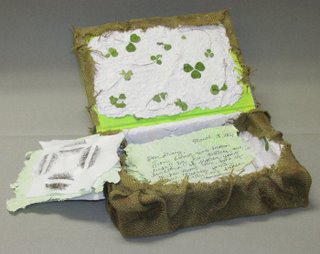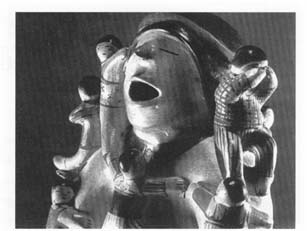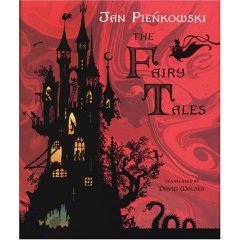New Book Roundup
 The Clue of the Linoleum Lederhosen by M. T. Anderson
The Clue of the Linoleum Lederhosen by M. T. Anderson
As a rule, it’s a good sign when I enjoy a book so much that I can’t wait to finish. It’s an even better sign when I can’t wait to tell everyone I know about a book. M. T. Anderson scores on both counts. Is it possible for a book to be so funny and poignant at the same time?
Here’s the jist: Lily Gefelty’s two best friends happen to be characters from children’s serial novels: there’s Katie Mulligan, star of the Horror Hollow series (think Goosebumps) and Jasper Dash, Boy Technonaut (think Danny Dunn). The three of them have decided that they need a break from solving mysteries and fending off the undead, so they head off to the Moose Tongue Lodge, where numerous other characters from popular series are staying (like the Manley Boys, the Cutesy Dell Twins, and Eddie Wax, star of the obscure “Newbery Honor” book, Stumpy Rides to Glory). Alas, soon after they arrive, they find that the famous Hooper Quints (think Bobbsey Twins) have been kidnapped, and a precious diamond necklace purloined. As Katie, Lily, and Jasper go about trying to solve the mystery, Anderson spends ample amounts of time parodying, satirizing, and down right pulling the underpants off of various clichés of children’s adventure novels. It’s precariously over-the-top at times; Anderson has nutty authorial asides, characters who are ludicrously stupid (the Manley Boys mistake a pepper grinder for a flashlight), and others who are downright bizarre (for example, a black-caped professor who studies bats, and spends time screaming every few seconds to mimic bats’ natural sonar capabilities). It’s a style that may come off as harried to some, but I enjoyed it immensely – Anderson’s ability to pull jokes out of left field and make them work reminds me of Douglas Adams. Here’s one of my favorite passages from the beginning of the book, and you’ll see why it’s so close to my heart:
Often, if you go down to a town library and under Keyword Search type “Jasper Dash,” you’ll come up with a list of his books – and beside each one, it says: “Withdrawn. Withdrawn. Withdrawn. Withdrawn.” This means that they are no longer in circulation. Some librarian has taken them off the shelf, wiping away a tear, and has opened the book to the back, where there’s a pouch for a card dating back to the time of the Second World War, and she’ll crumple up the card, and then she and her fellow librarians will take special knives and slice away at the book and will eat the pages in big mouthfuls until the book is all gone, the whole time weeping, because they hate this duty – it is the worst part of the job – for here was a boot that was once someone’s favorite, but which now is dead and empty. And the little cheerful face of Jasper Dash, heading off to fight a cattle-rustling ring in his biplane, will still be smiling pluckily as they take their Withdrawl Knives and scratch his book to pieces.
(My husband, after reading this passage, said, “Wow. I had no idea that’s what you librarians did in the back office.”)
For all the funny jokes, though, there’s an emotional side to the novel that is almost lyrical – Anderson uses the different series characters not only as a set-up for jokes, but also to elucidate the way that we tend to label and pigeonhole one another. Amazingly, Anderson manages to pull off a few elegiac passages at the end, and they manage to fit in with the rest of the zaniness seamlessly. It’s been a long time since I’ve met a book that made me laugh quite so hard, that made me smile so wistfully, and makes me eager to head over to the library to talk it up to the kids there. M. T. Anderson: I salute you.
Whoo. Long review on that one. Can you tell that I’m excited? Let’s make the others right quick, eh?
 Fairest by Gail Carson Levine
Fairest by Gail Carson Levine
Fans of Ella Enchanted will be raring to pick up this book. Quite frankly, I can’t imagine anyone who wouldn’t want to pick it up – look at that cover! It got hit with the Pretty Stick. Anyhow, Fairest is set in the same world as EE, but in the next kingdom over – in Ayortha, whose inhabitants are intensely musical. Aza is our protagonist, and while her voice is miraculous, she’s as plain as day. Enter pretty but tone-deaf Queen Ivi, and suddenly Aza is “Singin’ in the Rain”-ing it for her. As the Queen’s lady-in-waiting (and vocal stand-in), she notices a magical mirror on Queen Ivi’s dressing table, and wonders if it could help make her pretty. But will the Queen be jealous of Aza if she becomes beautiful? And what would Aza’s new best friend Prince Ijori think? Yep, you guessed it -- it’s a retelling of “Snow White.” However, Levine’s world is so finely fleshed out -- you can just tell how much she enjoyed describing things like gnome caverns and magical libraries for us – that the story feels new again. It’s missing a lot of the humor that peppered EE so nicely, but this fits the story’s tone just fine (Snow White is a more melancholy tale than Cinderella, anyway). There’s a smattering of court intrigue and talk of politics, but the real focus is on Aza’s journey to accepting her body image – a message that can always be repeated in this day and age. There’s just one thing that bothered me – Queen Ivi is such a transparent clotheshorse bimbo that I can’t imagine why the King Oscaro -- who, we are told over and over again, is so wise and good-hearted – managed to fall in love and marry her. What in the world did they have in common?!? Sheesh. Men.
Hmm. That was long-ish, too. On to Round Three!
 Adele & Simon by Barbara McClintock
Adele & Simon by Barbara McClintock
McClintock is my favorite under-appreciated illustrator right now. Her ink-and-watercolor pictures abound in fine detail and wit, and manage to be frothy without being fluffy. In this sweet book, Adele is charged with escorting her little brother home through turn-of-the-century Paris. He manages to lose his possessions one by one as they traipse through the Louvre, pastry shops, the natural history museum, and a plethora of other picturesque places in the city. Each page spread shows a lovely scene of the journey, just bursting with detail – people, animals, and objets d’art are vividly portrayed against a ochre-colored backgrounds. In each picture, the reader is invited to find the object that Simon has most recently lost, in a “Where’s Waldo?” style. The journey ends at the children’s home – and the lost possessions make their way back, too, in a manner that is immensely satisfying. Fun for anyone who’s ever had to herd little brothers home – or who is harboring a secret desire for Paris.
Ah . . . the third one was juuuuust right. And now off to bed!




